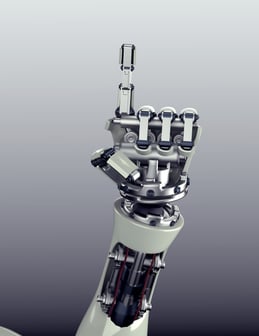 Manufacturers all over the world want to improve their bottom line. Finding ways to improve productivity, cut costs, and increase sales can help to make any manufacturer’s bottom line healthier.
Manufacturers all over the world want to improve their bottom line. Finding ways to improve productivity, cut costs, and increase sales can help to make any manufacturer’s bottom line healthier.
For a long time, manufacturers pursued the practice of offshoring their labor to developing nations as a means of cutting labor costs to improve profitability. However, the hidden costs of shipping delays and customs processing, combined with the rising minimum wage in many developing nation, have largely negated the advantage of offshoring to a manufacturer’s bottom line.
With this in mind, many manufacturers are now looking for new ways to improve their bottom line. One tool that manufacturers are beginning to adopt to help their bottom lines is the manufacturing robot.
How do manufacturing robots improve a manufacturer’s bottom line? Also, can a manufacturing robot improve your bottom line?
In an interview with Bloomberg business news, Scott Eckert, the CEO of Rethink Robotics pointed out a few of the ways in which robotics can help manufacturers improve their bottom line. Here's Marlin Steel's robotic IDEAL Welding Machine in action below!
The Cost of Manufacturing Robots is Decreasing
For many years, the use of manufacturing robotics was limited primarily to the automotive sector. As Scott said in his interview, “the technology has changed quite a bit. What we had before were essentially expensive, very precise, and inflexible machines.”
In the automotive industry, these robots made sense because they could handle the heavy loads involved in the automobile production process and didn’t need to handle a large variety of tasks. However, other manufacturing sectors either didn’t have the resources to deploy the big, clumsy machines that were available in the early days of robotics, or the machines weren’t cost-effective.
In recent years the cost of investing in this technology has gone down. This makes robotics more affordable and sensible as a means of handling production work.
The Capabilities of Manufacturing Robots Have Improved
In addition to becoming less costly to invest in, manufacturing robots have become much more robust than ever before.
The computing power of the CPUs being used to run manufacturing robots is increasing, and the sophistication of the average robotic armature has increased as well. This combination of better processing power and greater range of motion and articulation gives the newest generation of manufacturing robots vastly increased operational flexibility, allowing them to take on tasks that the older generation of robots could not handle.
Manufacturing Robots Improve Productivity
 Marlin Steel’s production team can personally attest to how much the use of manufacturing automation such as wire bending robots can improve productivity.
Marlin Steel’s production team can personally attest to how much the use of manufacturing automation such as wire bending robots can improve productivity.
Roughly 20 years ago, Marlin’s production team worked steel wire by hand. It was slow, tiring, and sometimes dangerous work, as wire shapers would lose body parts manually cutting and bending thick steel wire.
A skilled, dedicated worker going at top speed might complete as many as three or four bends in a piece of steel wire in a minute. As the day wears on, that worker will begin to tire, slowing down his or her rate of production and reducing the accuracy of the bends they make.
A wire bending robot, on the other hand, can make dozens of bends in steel wire each minute. Better yet, the bends will be consistent from one work piece to the next, so the final product made from the wires will be able to consistently meet the same production tolerances.
By making parts faster and reducing nonconforming parts rejections, manufacturing robots increase the productivity of a manufacturer per worker while saving money on materials.
Marlin leverages this increased productivity to provide clients with custom wire racks and baskets that can meet very demanding production tolerances such as the ones found in the aerospace industry.
See how Marlin helped other companies improve their production lines with custom-made parts and materials handling baskets created with advanced factory automation by reading the case study at the link below:


.gif)


